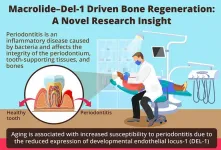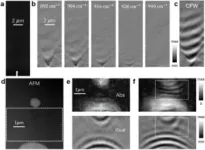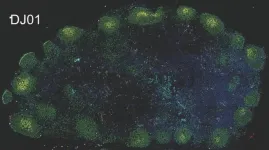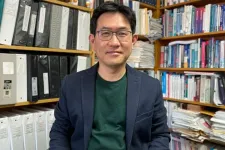Novel macrolide–DEL-1 axis drives bone regeneration in aging individuals
2024-01-25
(Press-News.org)
Niigata, Japan - Scientists from Niigata University discover macrolide-based molecules that increase the expression of DEL-1 protein and help in bone regeneration
Periodontitis is characterized by the loss of teeth resulting from inflammation of gums due to bacterial infections. The susceptibility to such bone loss disorders increases with age. The expression of the developmental endothelial locus-1 protein, crucial for bone regeneration, declines with age. Recently, researchers from Niigata University, University of Pennsylvania team identified a novel macrolide- DEL-1 axis that helps in bone regeneration and new bone formation. This finding may lead to the development of therapeutic agents to treat bone loss disorders.
Periodontitis is a serious gum infection that damages the soft tissue and destroys the bone that supports teeth. It is usually the result of poor oral hygiene that leads to bacterial infections. Aging may increase susceptibility to periodontitis by altering immune and regenerative functions. Development endothelial locus-1 (DEL-1), crucial for inflammation resolution and tissue repair, declines with age. The low levels of DEL-1 protein also affect bone regeneration and new bone formation capabilities in the elderly.
In a groundbreaking research endeavor, Research Professor Tomoki Maekawa, and a team of researchers from the Center for Advanced Oral Science, Niigata University, Japan, delved into the investigation of age-related periodontitis. "The motivation behind this study is rooted in the understanding that the prevalence of tooth loss due to periodontal disease and fractures in our super-aging society significantly diminishes the quality of life", explains Dr. Maekawa.
Their study highlights the ability of erythromycin to stimulate DEL-1 expression, promoting bone regeneration in aging mice. The non-antibiotic derivative EM-523, reproduces these effects. Mechanistically, macrolide treatments enhance bone formation and reduce osteoclasts, suggesting a potential therapeutic avenue for periodontitis-induced bone loss in humans, especially the elderly.
The research team observed a decline in DEL-1 expression with age and found that 12-month-old mice exhibited reduced bone regeneration compared to younger mice. Local microinjections of recombinant DEL-1-Fc in the gingiva of older mice rescued the bone regeneration deficiency.
Next, the team administered macrolides antibiotics, particularly erythromycin and its non-antibiotic derivative, EM-523, to 18 months old 'aged' mice and monitored the DEL-1 levels. Interestingly, DEL-1 levels were restored in treated mice and the increased levels of DEL-1 promoted the regeneration of bone that was lost due to naturally occurring age-related periodontitis. Further in-depth studies demonstrated the promising role of DEL-1, indicating new bone formation in the jaws and related gum tissues through increased alkaline phosphatase activity and osteogenic gene expression. It also revealed that macrolides influenced inflammation resolution and reduced osteoclastogenesis in a DEL-1-dependent manner. Additionally, EM-523 displayed similar effects and enhanced bone mass in femurs. Macrolides promote bone regeneration in aging individuals by modulating the DEL-1 protein, affecting the mesenchymal stromal and stem cell population in the periodontal ligament. Interestingly, macrolide antibiotics and EM-523, both failed to induce bone regeneration in age-matched DEL-1-deficient mice, confirming that DEL-1 is crucial for the observed bone-regenerating effects of the macrolides.
These findings suggest that targeting DEL-1 expression with macrolides could be a promising approach for promoting bone regeneration in aging individuals. EM-523, with its non-antibiotic properties, emerges as a promising candidate with fewer adverse reactions and the potential to prevent antimicrobial resistance. The study underscores the significance of understanding the immunomodulatory properties of macrolides for developing safe and effective clinical applications to improve bone regeneration in the elderly population.
"The use of drugs with established safety profiles can lead to the early development of an effective bone regeneration agent. We are hopeful that macrolide-based molecules can be developed further as a treatment option for periodontitis" concludes Res. Prof. Maekawa, addressing the real-life applications of his research work.
END
ELSE PRESS RELEASES FROM THIS DATE:
2024-01-25
Menopausal women who regularly swim in cold water report significant improvements to their physical and mental symptoms, finds a new study led by UCL researchers.
The research, published in Post Reproductive Health, surveyed 1114 women, 785 of which were going through the menopause, to examine the effects of cold water swimming on their health and wellbeing.
The findings showed that menopausal women experienced a significant improvement in anxiety (as reported by 46.9% of the women), mood swings (34.5%), ...
2024-01-25
Kiwifruit has proven itself as a powerful mood booster and new research from the University of Otago has shown just how fast its effects can be.
In a study, published in The British Journal of Nutrition, researchers found the furry fruit improved vitality and mood in as little as four days.
Co-author Professor Tamlin Conner, of the Department of Psychology, says the findings provide a tangible and accessible way for people to support their mental well-being.
“It’s great for people ...
2024-01-24
Women and people of colour remain invisible to many people in Britain and the USA as people pick white men as their heroes instead, a study shows. Their achievements are often forgotten or not recognised when people are choosing who inspires them, researchers have found.
Most people said their family and friends, people closest to them, were their heroes. These ‘everyday’ heroes accounted for one in three choices in Britian and 41 per cent in the US.
In both countries, politicians were popular as heroes, with more common choices including Ronald Reagan, Abraham Lincoln, ...
2024-01-24
In findings that have implications for potential new HIV therapies, researchers from Texas Biomedical Research Institute (Texas Biomed) used genetic sequencing techniques on the nonhuman primate version of the virus to identify that lymph nodes in the abdomen are the leading source of rebound infection after the first week of stopping antiretroviral treatment.
The study regarding simian immunodeficiency virus (SIV) was reported in the journal Science Translational Medicine. SIV is very closely related to HIV and is commonly used as a proxy to study HIV in animal models.
“Lymphoid tissues are known to be large ...
2024-01-24
Microplastics, with a size from 1 micron to < 5 millimeters, are pervasive pollutants that have been found in all parts of the global ocean, and have made their way into the marine food webs. Researchers, led by University of British Columbia UBC’s Institute for the Oceans and Fisheries scientists and Ecuadorian researchers from Galápagos and the ESPOL Polytechnic School (Guayaquil, Ecuador), looked closely at how microplastic bioaccumulation was affecting the endangered Galápagos penguin (Spheniscus mendiculus) as an indicator species to trace how deeply microplastic bioaccumulation has entered the food web in the isolated Galápagos Islands.
An ...
2024-01-24
Obesity is a problem in the United States. In fact, 42.5% of U.S. adults aged 20 and over have the disease. Not only is obesity the nation’s second leading cause of preventable death (behind only smoking cigarettes), it also leads to other serious health issues, including an increased risk of type 2 diabetes, high blood pressure, heart disease, stroke, cancer, sleep apnea and liver disease. The disease and its side effects impose a significant financial burden on America’s health care system.
As many make — and often fail to keep — New Year’s resolutions about exercise and weight loss goals, University ...
2024-01-24
LA JOLLA (January 22, 2024)—Salk Professor Ronald Evans has been named the 2024 recipient of the Japan Prize in the field of Medical Science and Pharmaceutical Science. The Japan Prize Foundation awards this prestigious international award annually to “express Japan’s gratitude to international society.”
"I am delighted to extend my congratulations to Ron for this well-deserved recognition in honor of his discovery of nuclear hormone receptors,” says Salk President Gerald Joyce. “This accomplishment not only reflects the exceptional caliber of Ron’s research ...
2024-01-24
UNSW medical researcher Dr David Jacques and his team have discovered how the human immunodeficiency virus (HIV) breaches the cell nucleus to establish infection, a finding that has implications beyond HIV biology.
To infect cells, HIV must enter the target cell and make its way to the nucleus in the cell’s centre where enough copies of its genetic code can be produced to infect other cells.
To safely complete this quest, the virus builds a protective protein coat – a capsid – to shield itself from the host’s immune defences geared to destroy it. Until ...
2024-01-24
On a cliffside at Mesa Verde National Park in southern Colorado, a fuzzy bee was industriously gnawing at the red sandstone. Making a loud grinding sound, the insect used its powerful jaws to drill tunnels and holes in rocks, where it would build a nest for raising offspring.
The bee, known as Anthophora pueblo, is a type of digger bee native to Colorado. Discovered less than a decade ago, the bee has quickly become Adrian Carper’s favorite pollinator.
“This is just one example of how crazily diverse our native bees are,” said Carper, an ...
2024-01-24
Mayo Clinic researchers studying the genetics of people who had recently developed dilated cardiomyopathy, one of the most common causes of heart failure, have found a particular gene to target for developing future drug therapy treatments. The disease makes it harder for the heart's left ventricle to pump blood effectively to the rest of the body. In this first genome-wide association study, the researchers sought to understand why some patients get better after developing the condition — and some don't.
"We found genetic variation in the CDCP1 gene, a gene that no one has heard of in ...
LAST 30 PRESS RELEASES:
[Press-News.org] Novel macrolide–DEL-1 axis drives bone regeneration in aging individuals







